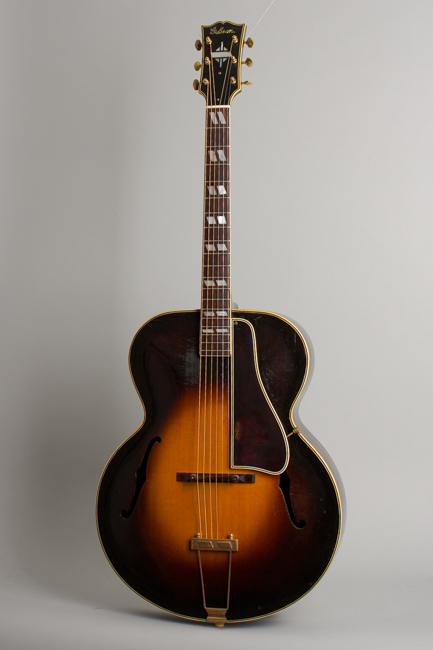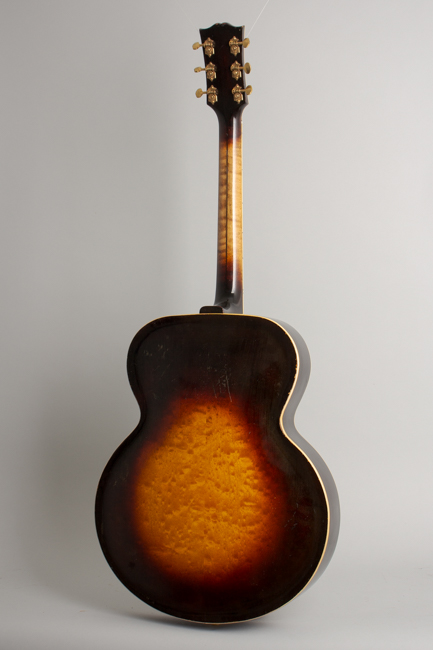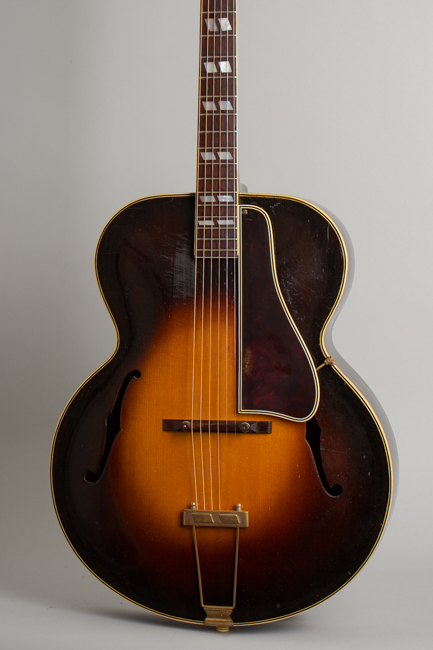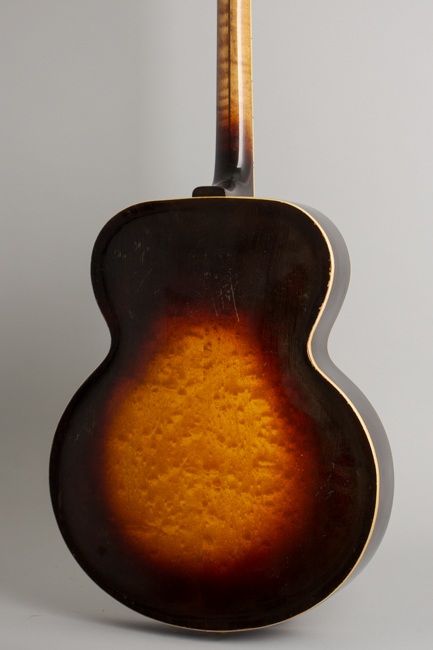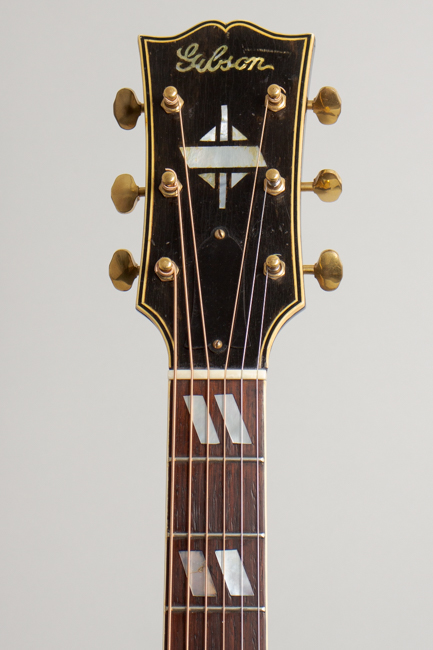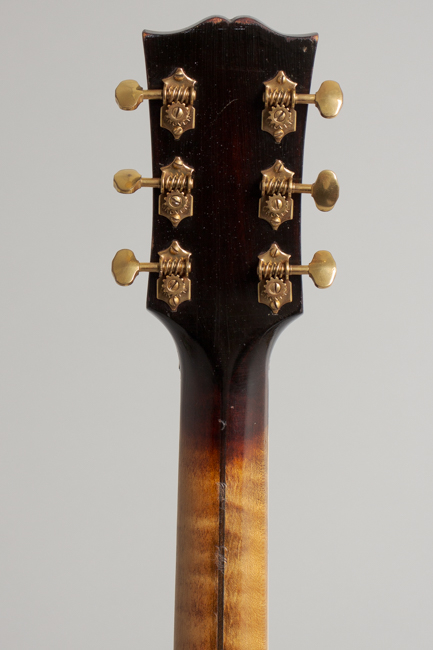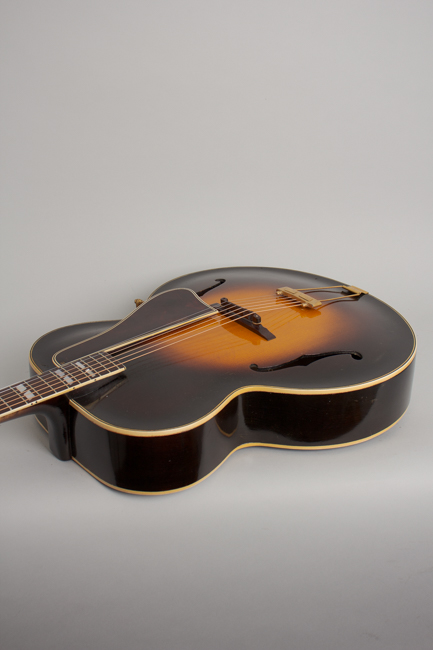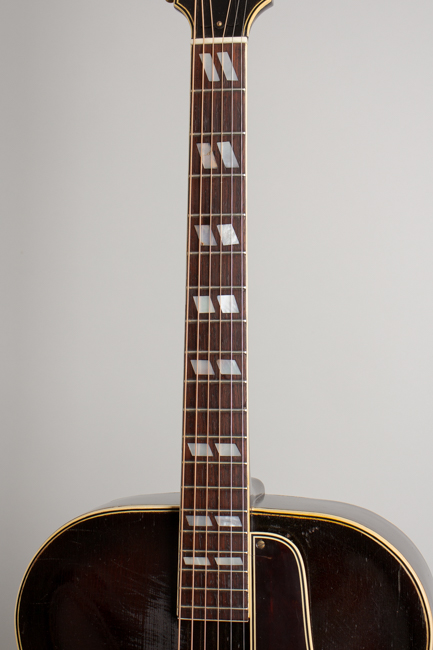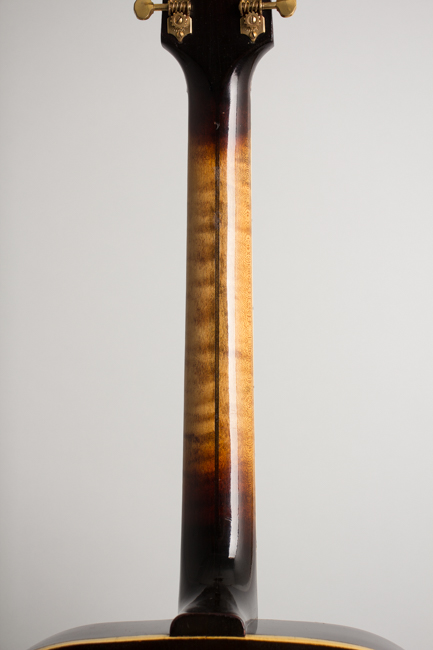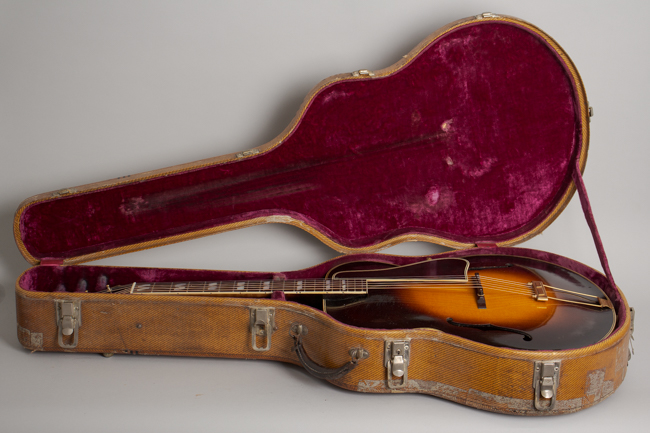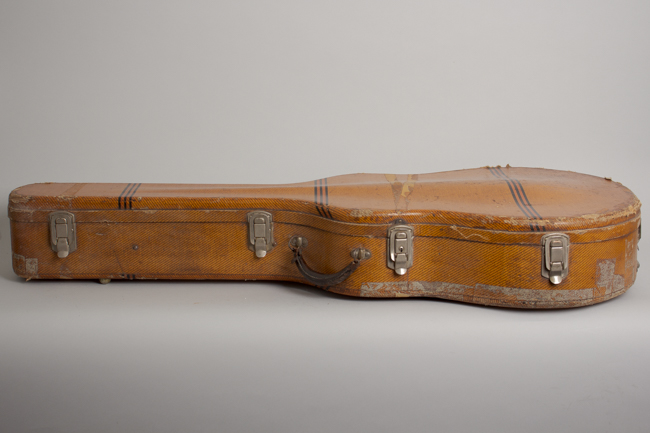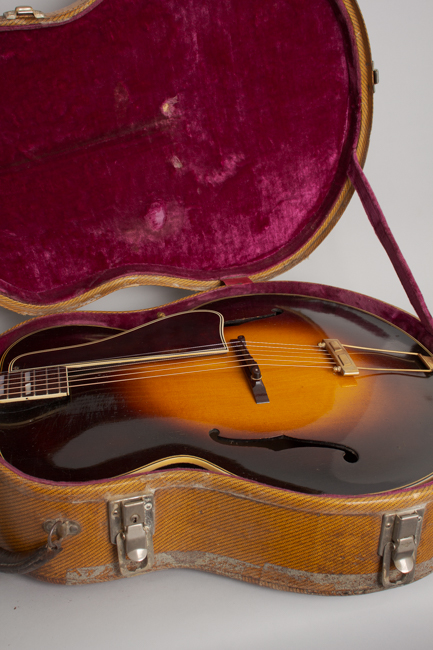Gibson L-12 Arch Top Acoustic Guitar (1937)
This item has been sold.
Item # 11620
Prices subject to change without notice.
Gibson L-12 Model Arch Top Acoustic Guitar (1937), made in Kalamazoo, Michigan, serial # 94525, sunburst lacquer finish, maple back and sides, spruce top; laminated' maple neck with rosewood fingerboard, original tweed hard shell case.
This is a fine playing and sounding example of an attractive pre-war Gibson archtop, the new-in-1935 "Advanced" 17" body L-12. Priced in 1937-8 at $187.50 (plus $28 for the case) this was the most expensive of three midline models in the improved "Advanced" larger-bodied line of orchestra guitars. A substantial professional grade instrument, the L-12 offered the same basic playing features as the $275 L-5 with less expensive trim, although not a plain guitar by any means.
Of the three instruments in this mid-30's line the L-12 is closest to L-5 specs with gold plated hardware and a 3-piece maple neck, neither of which were stock on the L-10 or L-7. The double parallelogram fingerboard inlay introduced on this model became a signature Gibson motif used on many future guitars. The pearl headstock inlay looks like a smaller take on the Super 400 split diamond; it was a short-lived design rarely seen beyond this model. The single bound fingerboard is rosewood, while the L-5 had ebony. The top, back and neck have a deep amber sunburst finish with solid dark colored rims.
This 1937 L-12 retains the original shorter 24 3/4" scale length soon to be changed to 25 1/2" and the X-braced top discontinued by 1940. This combination of features is particular to the mid-30s and gives the Gibsons of the period a somewhat mellower, sweeter ring than their Epiphone competition. The top is carved spruce, the back solid maple with an attractive burl figure in the center. The top, headstock and pickguard are bound with wide 3-ply celluloid; the hardware is gold plated including Grover openback tuners and an slim trapeze tailpiece with a design specific to this period.
This is a fairly rare guitar, a variation only in production for a couple of years and not an overly popular one at that. It is a beautiful looking and smooth and powerful sounding swing-era guitar, a subtle deco masterpiece with lots of class a very resonant tone.
Overall length is 42 in. (106.7 cm.), 17 1/8 in. (43.5 cm.) wide at lower bout, and 3 1/2 in. (8.9 cm.) in depth, measured at side of rim. Scale length is 24 3/4 in. (629 mm.). Width of nut is 1 11/16 in. (43 mm.).
Overall this remains a lovely original guitar, played but not much altered or abused over the last 85+ years. There is some typical checking to the finish, with pick scratching on the face above the fingerboard extension and dings, scratches and chips overall. There are several deep scratches in the upper center of the back. The back of the neck has a thin clear overspray over some worn sections, other than that the finish remains original.
There are no cracks detectable on the instrument at all. All hardware remains original and intact, showing less wear to the gold plating than many. The original celluloid pickguard has had the support bar underneath replaced; a small spot on the top that had started to outgas has been sealed and stabilized. The guitar looks to have been neatly refretted some time back with original style period correct wire, with the bone nut replaced. A couple of the pearl fingerboard inlays have small cracks or chips to the edges. Playability is excellent, and this very fine smooth sounding L-12 is housed in the original tweed HSC, externally worn but still completely serviceable. Overall Excellent - Condition.
This is a fine playing and sounding example of an attractive pre-war Gibson archtop, the new-in-1935 "Advanced" 17" body L-12. Priced in 1937-8 at $187.50 (plus $28 for the case) this was the most expensive of three midline models in the improved "Advanced" larger-bodied line of orchestra guitars. A substantial professional grade instrument, the L-12 offered the same basic playing features as the $275 L-5 with less expensive trim, although not a plain guitar by any means.
Of the three instruments in this mid-30's line the L-12 is closest to L-5 specs with gold plated hardware and a 3-piece maple neck, neither of which were stock on the L-10 or L-7. The double parallelogram fingerboard inlay introduced on this model became a signature Gibson motif used on many future guitars. The pearl headstock inlay looks like a smaller take on the Super 400 split diamond; it was a short-lived design rarely seen beyond this model. The single bound fingerboard is rosewood, while the L-5 had ebony. The top, back and neck have a deep amber sunburst finish with solid dark colored rims.
This 1937 L-12 retains the original shorter 24 3/4" scale length soon to be changed to 25 1/2" and the X-braced top discontinued by 1940. This combination of features is particular to the mid-30s and gives the Gibsons of the period a somewhat mellower, sweeter ring than their Epiphone competition. The top is carved spruce, the back solid maple with an attractive burl figure in the center. The top, headstock and pickguard are bound with wide 3-ply celluloid; the hardware is gold plated including Grover openback tuners and an slim trapeze tailpiece with a design specific to this period.
This is a fairly rare guitar, a variation only in production for a couple of years and not an overly popular one at that. It is a beautiful looking and smooth and powerful sounding swing-era guitar, a subtle deco masterpiece with lots of class a very resonant tone.
Overall length is 42 in. (106.7 cm.), 17 1/8 in. (43.5 cm.) wide at lower bout, and 3 1/2 in. (8.9 cm.) in depth, measured at side of rim. Scale length is 24 3/4 in. (629 mm.). Width of nut is 1 11/16 in. (43 mm.).
Overall this remains a lovely original guitar, played but not much altered or abused over the last 85+ years. There is some typical checking to the finish, with pick scratching on the face above the fingerboard extension and dings, scratches and chips overall. There are several deep scratches in the upper center of the back. The back of the neck has a thin clear overspray over some worn sections, other than that the finish remains original.
There are no cracks detectable on the instrument at all. All hardware remains original and intact, showing less wear to the gold plating than many. The original celluloid pickguard has had the support bar underneath replaced; a small spot on the top that had started to outgas has been sealed and stabilized. The guitar looks to have been neatly refretted some time back with original style period correct wire, with the bone nut replaced. A couple of the pearl fingerboard inlays have small cracks or chips to the edges. Playability is excellent, and this very fine smooth sounding L-12 is housed in the original tweed HSC, externally worn but still completely serviceable. Overall Excellent - Condition.
